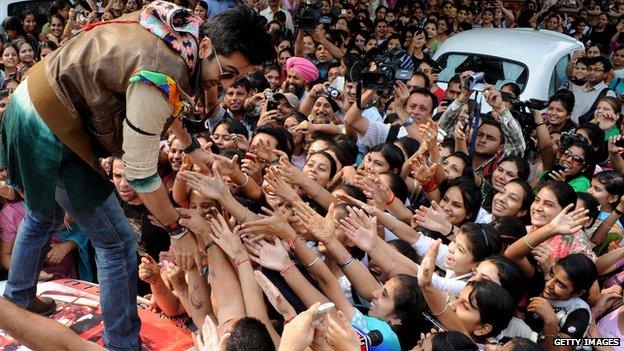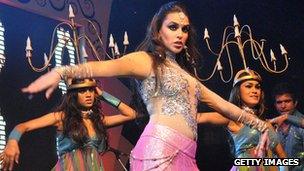How Bollywood transformed the face of Indian cinema
- Published

This month marks the centenary of Indian cinema. Over the last 100 years Mumbai's Hindi film industry - known as Bollywood - has become the biggest and best known of India's production centres.
When the Bollywood actor Amrish Puri played the villainous Mola Ram in Indiana Jones and the Temple of Doom the director - Steven Spielberg - described him as "my favourite villain, the best the world has produced and ever will".
In Bollywood, Amrish is best remembered for an over the top, some would say absurd role as Mogambo, a ridiculous, garish, outrageously dressed megalomaniac who aimed to conquer India in a film called Mr India.
Amrish's two roles illustrate the anomaly of Bollywood and the reason it is so underestimated.
It has produced actors, directors, musicians and technicians described by the renowned film critic Derek Malcolm as having "every right to be compared with the best of those from Hollywood", yet its output is so different.
And that is because it is aimed at an Indian audience.
The larger than life characters they like can all too easily be mistaken for parodies of reality. Yet those characters have consistently reflected the mood of India for 100 years.
The first silent Indian films were mythological, and so inevitably larger than life.
The myths represented a widespread desire to get rid of the British and restore India to its past glory.
In the early days of independence, national pride was high and it was believed that socialism would eradicate poverty.
In the classic film of that era, Mother India, there was a melodramatic scene when a village woman trapped in debt was bent double pulling a plough because she had been forced to sell her bullocks.
The problem of poverty was highlighted but so was the fortitude of the poor.
Sadly, socialism spawned a stifling bureaucracy which wound its tentacles round every sphere of national life, strangling the earlier optimism.
Bollywood reflected the despair of this era with the emergence of the angry young man, epitomised by the actor who was to become the greatest Bollywood star of all time, Amitabh Bachchan.
India came to a halt when he was seriously injured while filming one of the ferocious fights that were an essential element in those films.
The then Prime Minister Indira Gandhi never one to miss a chance to identify herself with the national mood, rushed to Amitabh's bedside in a Bombay hospital.
To take the nation's mind off the grim reality of the 1970s when the global oil price rise compounded the damage bureaucratic red tape was inflicting on the economy, Bollywood turned to teenage romance.
To lend reality to the film called Bobby which started this trend, the director chose a star who was only 16, Dimple Kapadia.
Indira Gandhi ordered the government-controlled television to screen Bobby in the hope that it would keep people at home when opposition leaders were holding a massive rally in Delhi demanding her resignation. It did not.
For many years India was prudish, so bare bellies, and clinging, wet saris were as far as directors would go.
Kissing was taboo. When another teenage star, Mandakani, stood in a waterfall, her sari so transparent that little was left to the imagination, there was a national outcry.
In a film just released to celebrate the centenary of Bollywood there is heterosexual and homosexual kissing, reflecting how the mood has changed.
In the centenary year India is enraged by scandals revealing rampant corruption, and Bollywood is reflecting this. In one recent film - Jolly LLB - businessmen, a judge, lawyers, and policemen are all corrupt.
Fortunately in the end the anti-hero judge becomes a hero, and one of the lawyers is shamed into honesty, so there is a traditional Bollywood happy ending.
Purists would probably regard the seedy judge and fast talking lawyer in Jolly LLB as over the top, but for the last 100 years the skilled artists of Bollywood have shown that Indians like larger than life characters to reflect their society.

The term "Bollywood" came from fusing "Hollywood" with the "B" of Bombay - now known as Mumbai
And that does not make them any less real.
Gulchan Grover, one of Amrish Puri's fellow villains liked to tell the story about the airline passenger who refused to sit next to him because to her he was as villainous in real life as he was on screen.
Changes have come, now that middle-class multiplex cinemas divide the Indian audience.
The poor can only afford the traditional one-screen cinemas where they provide a lively audience jeering when the villain comes on, cheering the hero, whistling and making other encouraging noises when there is any chance of a kiss.
If the heroine is reluctant to kiss the audience will shout "give me one" and when the songs are what are known as item numbers, that is to say raunchy numbers, the audience will join in the dancing.
The Bollywood director Shayam Benegal told me he does now paint with a less broad brush keeping the more sophisticated middle-class multiplex audiences in mind.
But the colours are still Bollywood bright.
How to listen to From Our Own Correspondent, external:
BBC Radio 4: Saturdays at 11:30 and some Thursdays at 11:00
Listen online or download the podcast.
BBC World Service: Short editions Monday-Friday - see World Service programme schedule.
You can follow the Magazine on Twitter, external and on Facebook, external